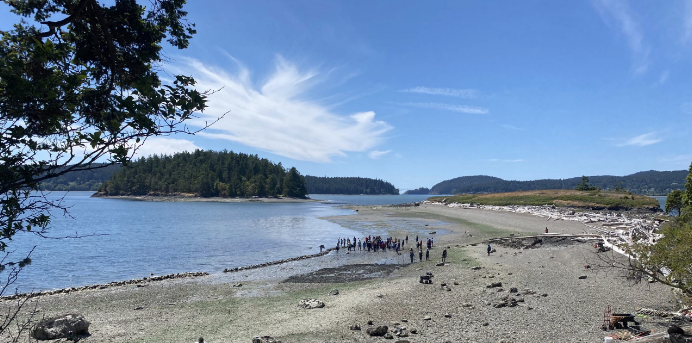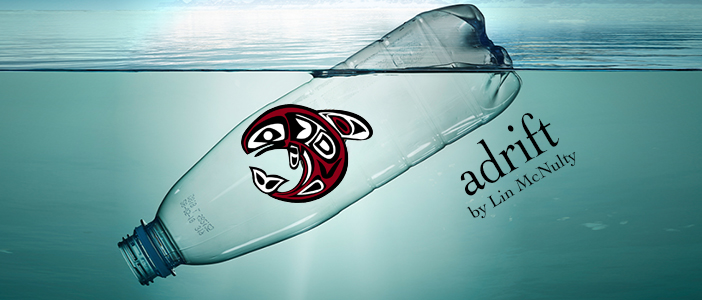The clam garden built by the Swinomish Indians with the help of people from Hawaii and elsewhere provides lessons for our own cultural practices.
||| FROM HONOLULU CIVIL BEAT ||| forwarded by SJ Makers Guild
While the crew on the voyaging canoe Hokulea sailed around Alaska, meeting with various Alaska Natives before a four-year circumnavigation of the Pacific, there was another meeting of Indigenous peoples, including those from Hawaii, in Washington state.
About two dozen people from Hawaii — mostly aquaculture practitioners from various fishponds — traveled to Kukutali Preserve, about a 90-minute drive north of Seattle. They helped build a wall for a traditional clam garden, a mariculture practice used by the Swinomish Indian Tribal Community to optimize clam production and increase species diversity. The garden is similar to the Native Hawaiian aquaculture practice of loko ia kuapa, or rock-walled fishponds.
Last week dozens of people representing nearly 30 tribes — from Hawaii, Washington, British Columbia, Alaska, Guam and Palau — showed up to help the Swinomish tribe complete the wall encircling the clam garden as part of the 2023 Salish Summit, a multi-day event that brings together tribes in the Cross-Pacific Indigenous Aquaculture Collaborative.
Working during low tide on a beach on Kiket Island, the volunteers — many wearing shorts and boots — placed about 10 tons of stones on a porous 200-foot-long, knee-high wall. Others worked on “fluffing” the sediment. Using pitchforks and shovels, they aerated the sediment to create a better environment for the butter clams and littleneck clams that grow here.
The garden can attract other marine life, too, including sea cucumbers, sea urchins, starfish, crabs and octopus. This is thought to be one of the first clam gardens to be built in the U.S. in 200 years.
There’s a familiar saying among Native communities on the Northwest coast of the U.S.: “When the tide goes out, the table’s set.” This highlights the importance of shellfish to Native cultures in this part of the world — and how vital these intertidal marine habitats are to growing this traditional food source for generations.
“It was my first time ever seeing a clam garden,” says Wally Ito, head of the Ewa Limu Project and founder of the Limu Hui — a Hawaii limu expert — who attended the summit. “My vision was that we were going to build something more like a loko ia — higher, taller, more substantial. But it wasn’t that at all.”
This was the second gathering of this collaborative, a group of Pacific-region research organizations and Indigenous communities with the goal of sharing cultural knowledge and advancing indigenous aquaculture. In February 2020 — right before the Covid-19 pandemic shut down travel — more than 170 people convened at the 800-year-old Heeia fishpond on Oahu to help restore the rock wall and learn about Native Hawaiian aquaculture practices. The group is already planning its third gathering, this time to Alaska.

Interest in Indigenous aquaculture has been growing in the U.S., with people looking at traditional mariculture methods as solutions to global climate change that’s affecting weather, water temperatures and sea level. Even in Hawaii, cultural practitioners and community leaders are noticing more interest and involvement in traditional practices like fishpond restoration.
“I think it’s the result of one or two generations of people teaching and bringing others to fishponds, teachers changing the way they teach. In just every aspect, there’s a lot more awareness and growth,” says Brenda Asuncion, the Hui Malama Loko Ia coordinator for the nonprofit Kuaaina Ula Auamo and founding steering committee member of the Indigenous aquaculture collaborative, who attended the summit. “That’s been consistent for the past 10 years now.”
The collaborative is a result of three Sea Grant programs — Hawaii, Washington and Alaska — realizing the importance of perpetuating and sharing Indigenous aquaculture through the networking with other Native practitioners. Right now there are about 20 different partners in the collaborative, from community nonprofits to tribal nations.
“There’s a collective action potential from this group coming together and sharing strategies or working together to push for improvements in things like policies and funding expectations,” says Katy Hintzen, a coastal resilience specialist with Hawaii Sea Grant and founding member of the collaborative. “While Sea Grant has been supportive and plays a role in this, I see this as really more of a grassroots effort. The power comes from all these different indigenous and tribal communities coming together and supporting each other.”
Because there’s a lot of manao to learn and share.
The clam garden, for example, is a symbolic reclamation for the Swinomish community. It sits on Kukutali Preserve (Swinomish for “place of cattail mat”), an 83-acre area that spans three islands with more than 2 miles of natural shoreline.
With the help of the Trust for Public Land, Washington State Parks acquired the property in 2010 after it had been privately owned for almost 100 years, and it’s now under the stewardship of the Swinomish Indian Tribal Community. It’s the first tribal state park in the U.S. to be co-owned and jointly managed by a federally recognized Indian tribe and a state government.
In addition, the Swinomish people aren’t just restoring clam gardens — the way people in Hawaii are restoring ancient fishponds. They are building new ones, something Asuncion finds inspiring.
“Right now we’re focusing on restoring existing structures, and that’s the framework that’s allowed within the permitting world here,” she explains. “What they’ve done (in Washington) is really phenomenal. They’re building something new. They’re extending their practice into the future. That’s really inspiring to me.”
Ito explains that clam gardens have been in production for thousands of years, and the Indigenous caretakers have had to adapt to various changes in weather, topography and other impacts. We need to do the same here.
“So much of our modern scientific strategy is to fight nature,” Ito says. “But one of the biggest messages I got (from the summit) was to adapt. You’ve just got to work with nature.”
**If you are reading theOrcasonian for free, thank your fellow islanders. If you would like to support theOrcasonian CLICK HERE to set your modestly-priced, voluntary subscription. Otherwise, no worries; we’re happy to share with you.**








